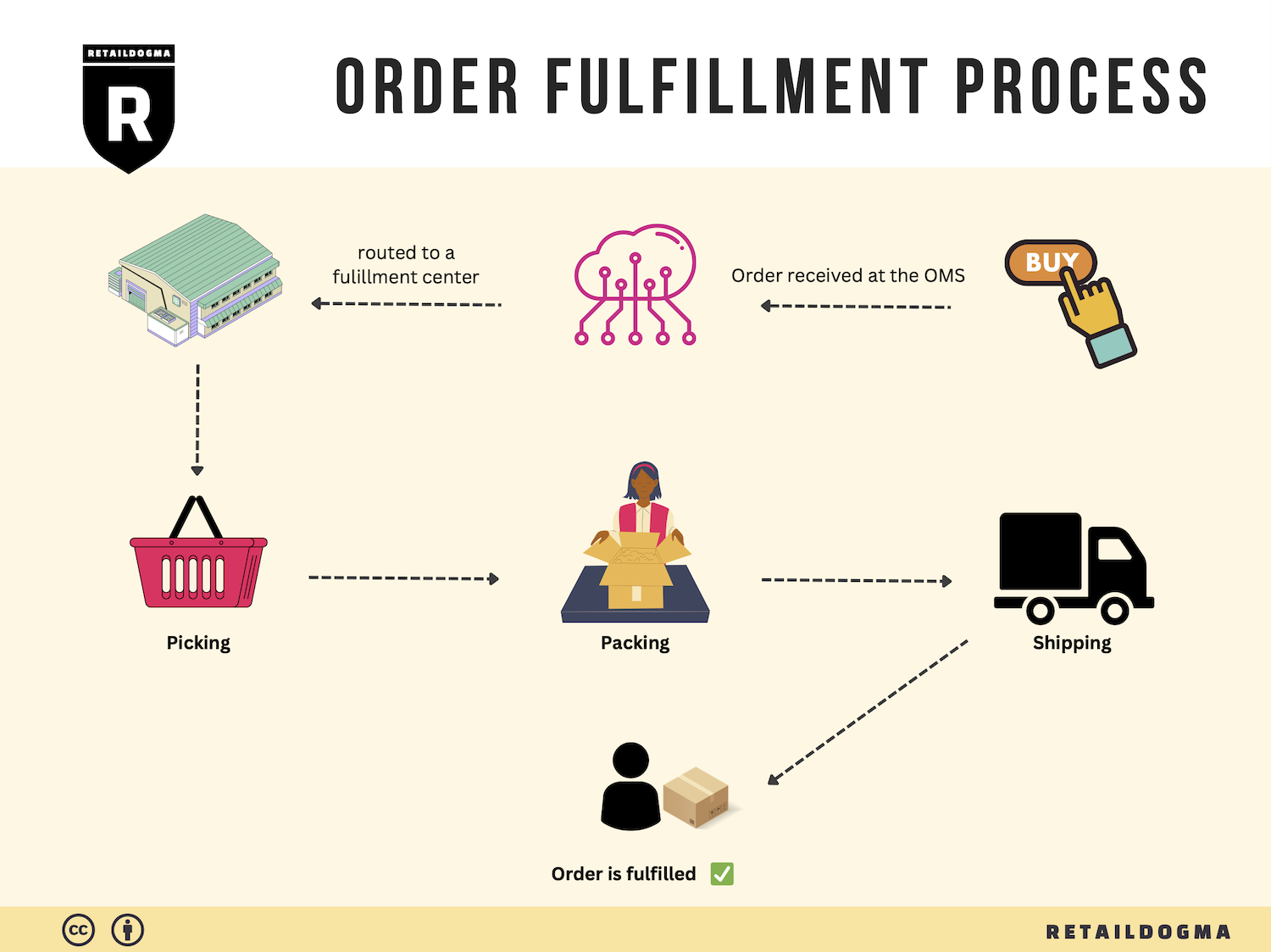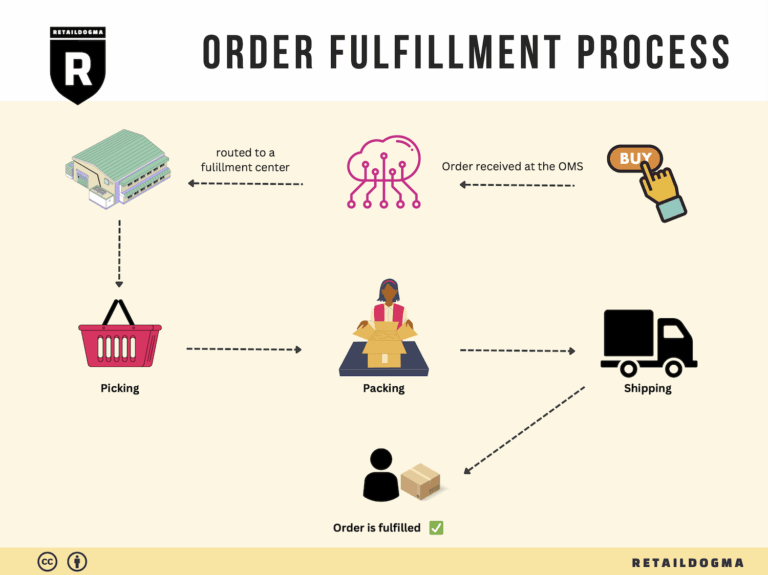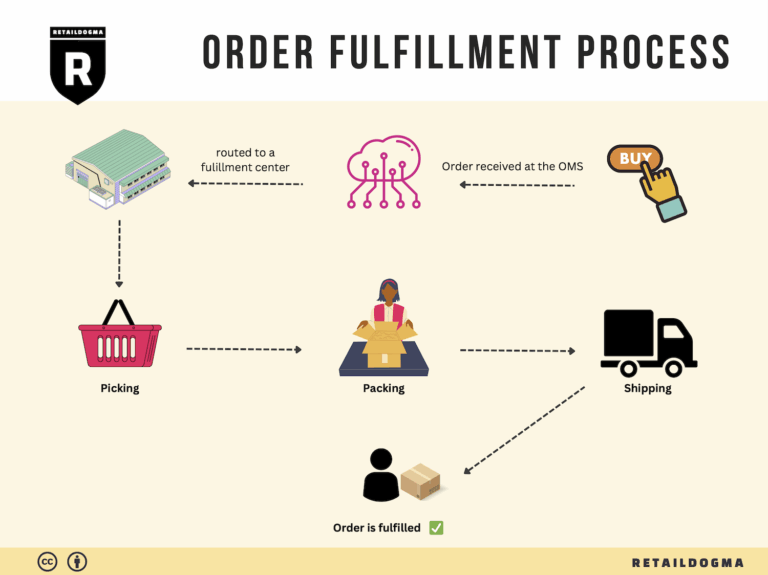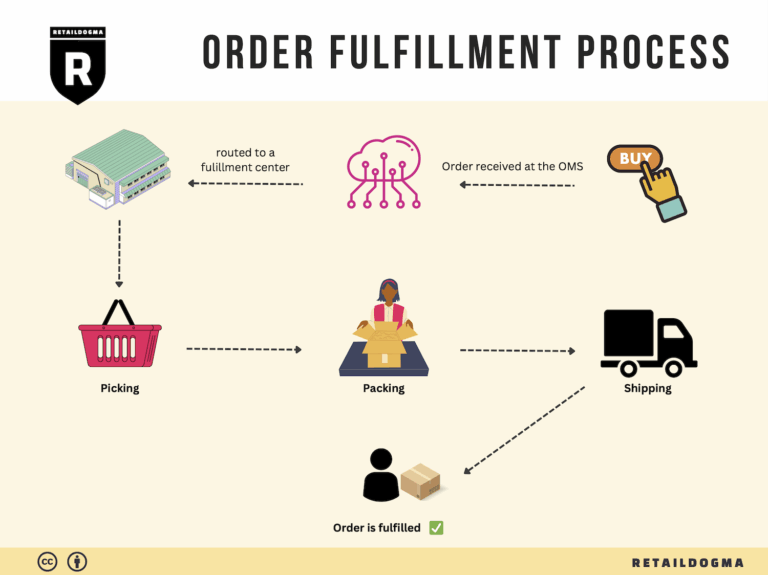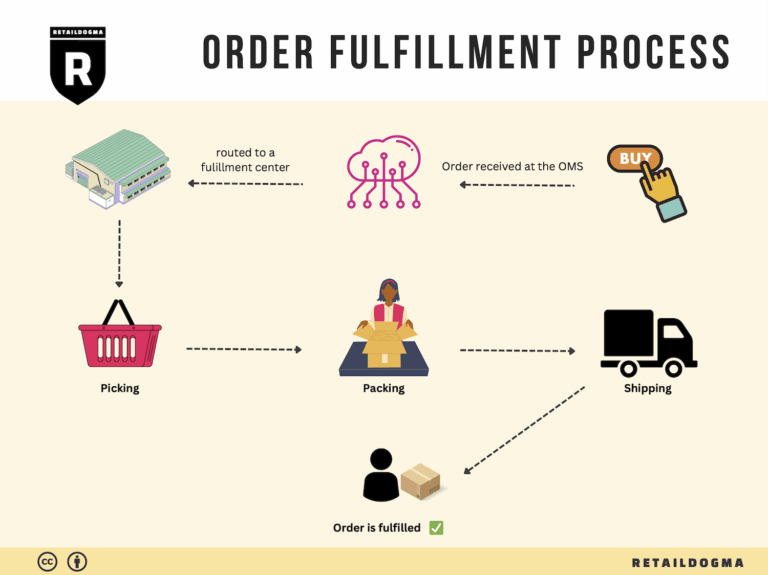Ecommerce Fulfillment Services: The Ultimate Guide (2025)
What is E-commerce Fulfillment? An Introduction for Growing Businesses
Understanding E-commerce Fulfillment
For many growing online businesses, the excitement of scaling sales can quickly turn into a daunting challenge, especially when it comes to packing and shipping orders. The influx of orders can overwhelm even the most organized entrepreneurs, leading to late shipments, errors, and dissatisfied customers. This is where e-commerce fulfillment comes into play—it’s the lifeline that enables businesses to efficiently deliver products to their customers.
At its core, e-commerce fulfillment refers to the entire process of getting a product from your online store to your customer’s doorstep. This encompasses everything from receiving and storing inventory to picking, packing, and shipping orders. As your business grows, the complexities of fulfillment can multiply, making it essential to understand your options and streamline your operations.
In this guide, we will explore the various fulfillment models available to e-commerce businesses, including third-party logistics (3PL) and Fulfillment by Amazon (FBA). Each model has its unique advantages and challenges, and understanding these differences will help you make an informed decision about what best fits your business needs.
We will also delve into the core services that fulfillment providers offer. These services typically include inventory management, order processing, returns handling, and shipping logistics. Knowing what to expect from a fulfillment partner can significantly impact your operational efficiency and customer satisfaction.
Choosing the right fulfillment partner is critical to your business’s success. We’ll provide practical tips on evaluating potential partners, considering factors such as location, scalability, technology integration, and pricing structures. Understanding how to assess these elements will empower you to form a partnership that aligns with your growth objectives.
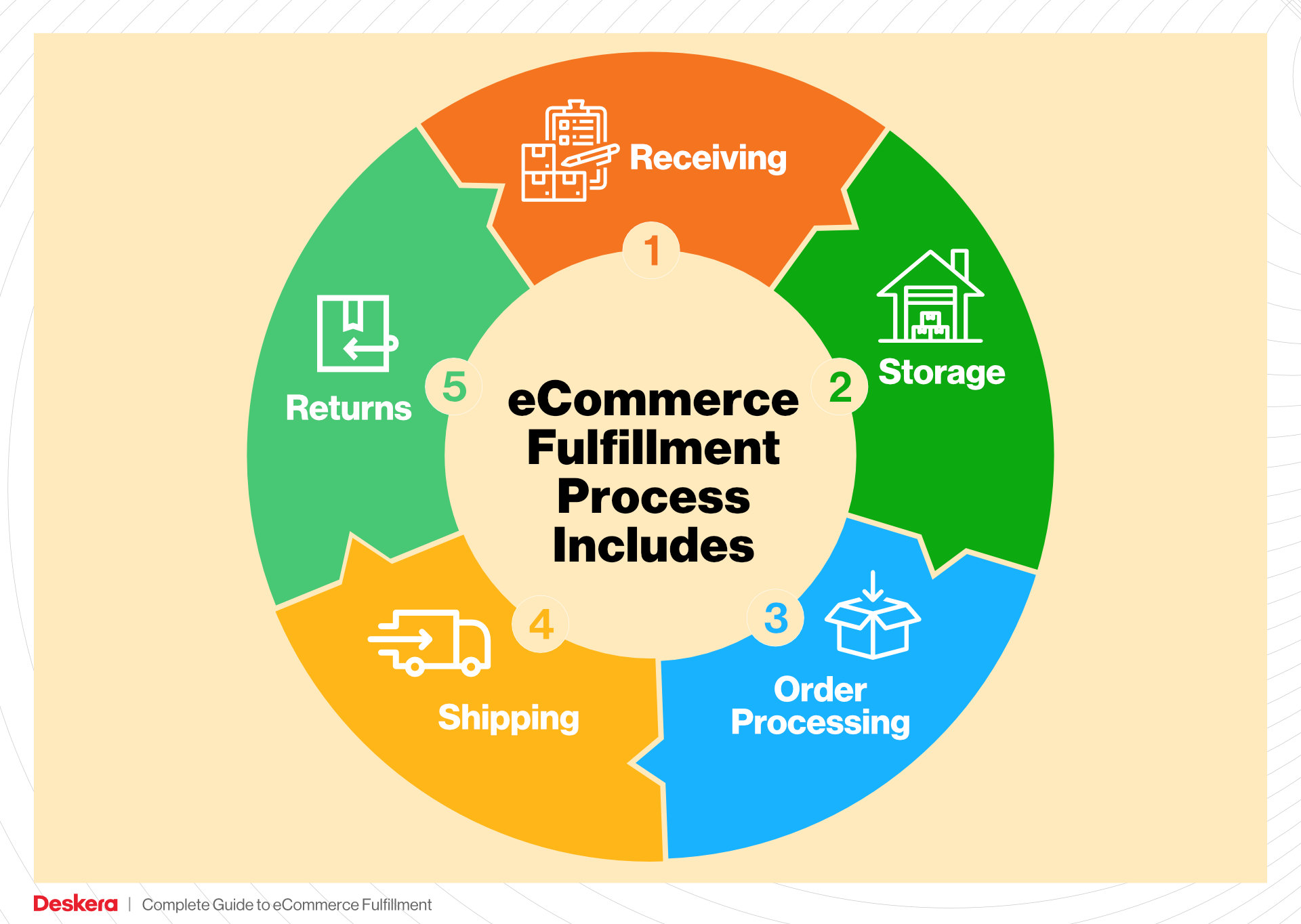
Finally, we will break down the pricing models associated with e-commerce fulfillment. Transparent pricing is crucial for managing your costs and maximizing profitability. We’ll discuss the various fee structures you may encounter and how to negotiate favorable terms.
The goal of this guide is to empower you with the knowledge needed to navigate the logistics landscape confidently. By understanding e-commerce fulfillment, you can make strategic decisions that enhance your operational efficiency, improve customer satisfaction, and ultimately drive your business growth. Let’s embark on this journey to streamline your fulfillment process and elevate your e-commerce success.
What You’ll Learn In This Guide
- What is E-commerce Fulfillment? An Introduction for Growing Businesses
- The Order Fulfillment Process: From ‘Buy’ Button to Customer’s Door
- Comparing Fulfillment Models: In-House vs. 3PL vs. Dropshipping
- A Deep Dive into Amazon FBA: Pros, Cons, and Who It’s For
- Core Services Offered by Fulfillment Centers
- How to Choose a Fulfillment Partner: A 6-Point Checklist
- Understanding Fulfillment Pricing: A Breakdown of Common Fees
- Frequently Asked Questions (FAQs) about Fulfillment
- Conclusion: Is Outsourcing Fulfillment the Right Move for Your Business?
- Important Disclaimer
The Order Fulfillment Process: From ‘Buy’ Button to Customer’s Door
1. Receiving Inventory
The order fulfillment process begins with receiving inventory, which is a critical step in ensuring that your warehouse is stocked with the products you plan to sell. During this phase, goods are delivered to your fulfillment center from suppliers or manufacturers.
Upon arrival, each shipment is carefully inspected for accuracy and quality. This is where the use of Stock Keeping Units (SKUs) becomes essential. SKUs are unique identifiers for each product, enabling accurate tracking and management of inventory levels. By confirming that the correct SKUs are received and in good condition, you set the foundation for a smooth fulfillment process.
Why is this step important? Effective inventory management directly impacts your ability to fulfill customer orders promptly. If inventory is not received accurately, you risk stockouts or delays, which can lead to customer dissatisfaction and lost sales. Therefore, investing in a robust receiving process ensures that you maintain optimal stock levels and can quickly respond to customer demand.
2. Warehouse Storage
Once inventory is received, the next step is warehouse storage. This involves organizing and storing products in a manner that maximizes space and facilitates efficient picking later in the process. Proper warehouse management systems (WMS) play a pivotal role here, allowing you to track where each SKU is located and manage stock levels in real time.
Strategically placing items based on factors such as size, weight, and demand frequency is essential for minimizing the time spent locating products during order picking. High-demand items should be placed closer to the packing area to streamline the process.
This step is crucial because well-organized storage not only enhances operational efficiency but also reduces the likelihood of errors during picking. Additionally, it enables faster retrieval times, ensuring that orders can be processed and shipped promptly, which is vital for maintaining customer satisfaction.
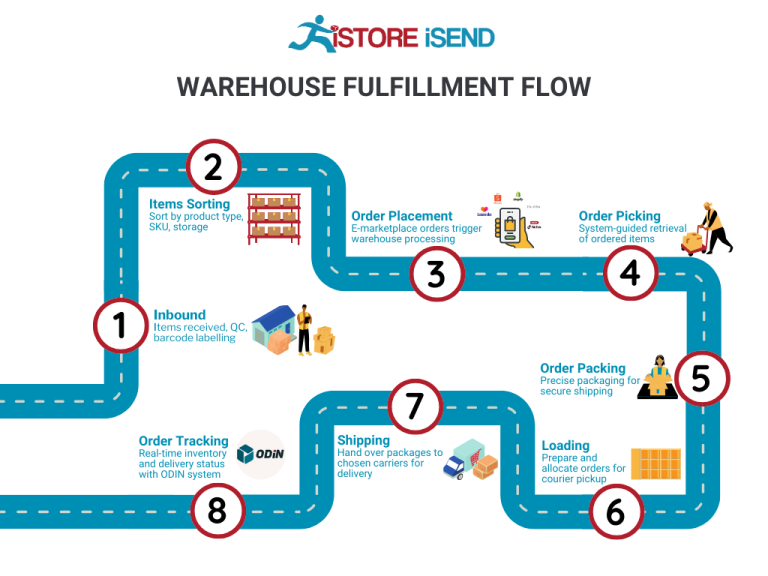
3. Order Picking
Order picking is the stage where fulfillment becomes tangible, as products are selected from the warehouse to fulfill customer orders. During this process, staff or automated systems utilize pick lists—documents that detail the SKUs and quantities needed for each order.
There are various picking methods, such as single order picking, batch picking, or zone picking, each suited to different business models and order volumes. Choosing the right method can significantly improve efficiency and reduce labor costs.
Why is order picking important? It directly affects the speed and accuracy of order fulfillment. Errors during this stage can lead to incorrect shipments, resulting in returns and customer dissatisfaction. Therefore, implementing efficient picking processes and utilizing technology to support staff can dramatically enhance fulfillment operations.
4. Order Packing
After items have been picked, the next step is order packing. This involves preparing the selected products for shipment, ensuring they are securely packaged to prevent damage during transit. Packing stations should be equipped with the necessary materials—boxes, tape, cushioning materials—along with packing slips that include order details.
In this phase, it’s essential to consider the unboxing experience for customers. Custom packaging can enhance brand perception and customer satisfaction, making this step more than just a logistical necessity.
The significance of packing lies in its impact on delivery performance and customer experience. Properly packed orders minimize the risk of damage during shipping, while attention to detail can turn a simple delivery into a memorable brand interaction. Poor packing can lead to increased return rates and dissatisfied customers, so investing in quality packing processes is vital for long-term success.
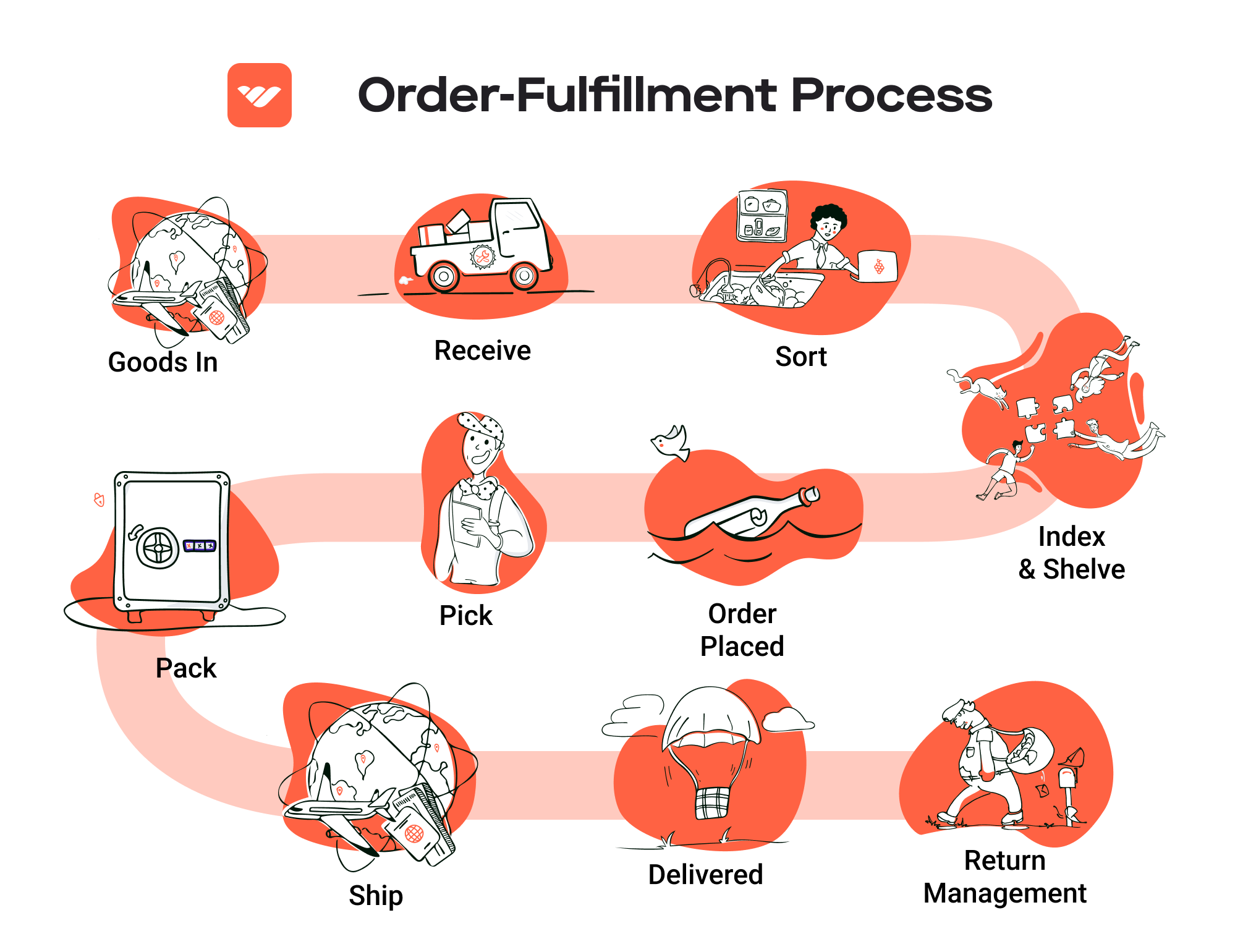
5. Shipping & Delivery
The final step in the order fulfillment process is shipping and delivery. Once packages are packed, they are labeled and dispatched to the chosen carriers for transport to customers. This stage is governed by a combination of logistics management and carrier selection, which can greatly influence delivery speed and cost.
Efficient shipping strategies involve choosing the right carrier based on factors such as destination, delivery speed, and cost-effectiveness. Many businesses leverage partnerships with third-party logistics providers (3PLs) to optimize their shipping processes and expand their reach.
The importance of this step cannot be overstated, as timely delivery is often a key determinant of customer satisfaction. Customers increasingly expect fast shipping options, including same-day or next-day delivery. Therefore, a streamlined shipping process, supported by data and technology, is essential for meeting customer expectations and enhancing overall fulfillment efficiency.
In summary, each step of the order fulfillment process—from receiving inventory to shipping and delivery—plays a crucial role in ensuring that e-commerce businesses can scale effectively while maintaining high levels of customer satisfaction. By optimizing these processes, businesses can significantly enhance their operational efficiency and competitive edge in the market.
Comparing Fulfillment Models: In-House vs. 3PL vs. Dropshipping
Fulfillment Model Comparison
| Model | Who Handles Inventory | Best For (Business Stage) | Key Advantage | Key Disadvantage |
|---|---|---|---|---|
| In-House Fulfillment | The business itself | Startups and small businesses | Full control over inventory and processes | High overhead costs and scalability issues |
| Third-Party Logistics (3PL) | A third-party provider | Growing businesses and scaling brands | Cost-effective and scalable fulfillment | Less control over inventory management |
| Dropshipping | Supplier or manufacturer | New businesses with limited capital | Low startup costs and no inventory risk | Lower profit margins and longer shipping times |
In-House Fulfillment
In-house fulfillment involves managing the entire logistics process within your own business. This means that you handle inventory storage, order processing, packing, and shipping directly from your own facilities. This model is particularly suitable for startups and small businesses that want to maintain full control over their inventory and the customer experience. By keeping fulfillment in-house, businesses can ensure quality control and customize the packaging and shipping processes to align with their brand identity. However, this model comes with significant challenges, including high overhead costs related to warehouse space, staffing, and technology investments. Additionally, as demand grows, scaling operations can become increasingly complex and resource-intensive, potentially leading to fulfillment delays and decreased customer satisfaction.
Third-Party Logistics (3PL)
Third-party logistics (3PL) providers, such as ShipBob or UPS, offer businesses the ability to outsource their fulfillment operations. This model is ideal for growing businesses and those looking to scale rapidly without the burden of managing their own logistics. With a 3PL, companies can tap into established networks of fulfillment centers, which allows for better inventory distribution, faster shipping times, and reduced shipping costs. The key advantages of using a 3PL include access to advanced technology for inventory management and logistics, as well as the ability to focus on core business functions like marketing and product development. However, businesses may face challenges related to reduced control over inventory management and potential issues with communication and coordination with the fulfillment partner. It’s essential for businesses to carefully choose a reliable 3PL that aligns with their operational needs and customer expectations.
Dropshipping
Dropshipping is a fulfillment model where the retailer does not keep the products it sells in stock. Instead, when a customer places an order, the retailer purchases the item from a third-party supplier, who then ships it directly to the customer. This model is particularly appealing for new businesses with limited capital, as it requires little upfront investment in inventory. The key advantage of dropshipping is that it minimizes the financial risk associated with unsold inventory and allows for a wide product selection without the need for storage space. However, dropshipping can also present significant disadvantages, including lower profit margins due to reliance on suppliers, limited control over product quality and shipping times, and potential for longer delivery periods, which can lead to customer dissatisfaction. Businesses utilizing this model must carefully vet their suppliers and maintain clear communication to ensure a positive customer experience.
In summary, each fulfillment model offers distinct advantages and challenges. Choosing the right one depends on the specific needs, goals, and growth stage of your e-commerce business. Understanding these models can empower business owners to make informed decisions that align with their operational capabilities and customer expectations.
A Deep Dive into Amazon FBA: Pros, Cons, and Who It’s For
Understanding Fulfillment by Amazon (FBA)
Fulfillment by Amazon (FBA) is a service provided by Amazon that allows sellers to store their products in Amazon’s fulfillment centers. Amazon takes care of storage, packaging, and shipping, as well as customer service and returns for these products. This service enables sellers to leverage Amazon’s vast logistics network, making it easier to reach millions of customers worldwide.
How FBA Works
-
Setting Up Your Account: To get started with FBA, sellers need to create an Amazon Seller account. Once set up, sellers can choose which products they want to fulfill through FBA.
-
Shipping Inventory to Amazon: Sellers send their products to Amazon’s fulfillment centers. Amazon provides specific guidelines on how to prepare and package products to ensure they meet their standards.
-
Storage and Inventory Management: Once products arrive at the fulfillment center, Amazon takes care of storing them. Sellers can manage their inventory through the Amazon Seller Central dashboard, allowing them to monitor stock levels and sales.
-
Order Fulfillment: When a customer orders a product, Amazon picks, packs, and ships the item on behalf of the seller. This process is highly automated, ensuring quick processing times.
-
Customer Service and Returns: Amazon also handles all customer service inquiries and returns related to FBA products, allowing sellers to focus on other aspects of their business.
Pros of Using FBA
1. Prime Eligibility
One of the most significant advantages of using FBA is that products become eligible for Amazon Prime. This status not only boosts visibility but also attracts Prime members who are looking for fast and free shipping options. As a result, sellers can see increased sales and customer loyalty.
2. Enhanced Customer Trust
Amazon is a trusted name in e-commerce, and utilizing FBA allows sellers to benefit from that trust. Customers feel more confident purchasing products fulfilled by Amazon due to the reliable shipping and customer service guarantees associated with the platform.
3. Multi-Channel Fulfillment
FBA is not limited to Amazon.com. Sellers can use Amazon’s fulfillment services for orders coming from other sales channels, including their websites or other marketplaces. This multi-channel fulfillment capability helps sellers streamline their logistics while maintaining consistency in service.
4. Scalability
FBA is designed to help businesses scale. As order volumes increase, sellers can rely on Amazon’s infrastructure without needing to invest in their own warehousing and logistics operations. This scalability is particularly beneficial for seasonal businesses or those experiencing rapid growth.
5. Automated Logistics
With FBA, sellers can automate many logistics processes, from inventory management to shipping. This reduces the burden on sellers and allows them to focus on marketing and growing their business rather than day-to-day operations.
Cons of Using FBA
1. High Fees
While FBA provides numerous benefits, it comes with significant costs. Sellers must pay storage fees for their inventory, as well as fulfillment fees for each order processed. These costs can quickly add up, particularly for low-margin products, affecting overall profitability.
2. Strict Inventory Rules
Amazon has strict policies regarding inventory management. Sellers must adhere to guidelines on inventory levels, packaging, and labeling. Failure to comply can result in penalties, including additional fees or even account suspension.
3. Commingling Risks
FBA operates a commingling system where products from different sellers may be stored together. This can lead to issues if a customer receives a damaged or counterfeit product. Sellers are at risk of negative reviews and potential account issues stemming from issues they did not cause.
4. Loss of Control
When using FBA, sellers relinquish a degree of control over their inventory and customer interactions. This can lead to challenges in maintaining brand consistency and delivering a personalized customer experience.
5. Complicated Returns Process
While Amazon handles returns, the process can be complicated for sellers. Products returned to Amazon may not always be in sellable condition, and sellers may face challenges in reclaiming their inventory or managing returns effectively.
Who is FBA Best For?
Fulfillment by Amazon is best suited for sellers who:
-
High Sales Volume: Sellers with a high volume of sales can benefit from the economies of scale that FBA offers, making it more cost-effective despite the fees.
-
Small to Medium-Sized Businesses: Companies looking to expand their reach without investing heavily in logistics infrastructure can find FBA an attractive option.
-
Seasonal Businesses: Businesses that experience seasonal spikes in sales can leverage FBA to manage increased demand without the long-term commitment of additional warehousing.
-
E-commerce Startups: Startups looking to establish a presence on Amazon can benefit from the trust and logistics support that FBA provides, allowing them to focus on product development and marketing.
-
Businesses Seeking Global Reach: Companies aiming to sell internationally can utilize FBA’s global network, simplifying the complexities of international shipping and customs.
In conclusion, while Fulfillment by Amazon offers many advantages, it also comes with challenges that sellers must consider carefully. For those willing to navigate the complexities, FBA can be a powerful tool for scaling an e-commerce business effectively.
Core Services Offered by Fulfillment Centers
Inventory Management & Warehousing
Inventory management and warehousing are foundational services provided by fulfillment centers that enable e-commerce businesses to maintain optimal stock levels while reducing storage costs. Fulfillment centers offer advanced warehouse management systems (WMS) that allow businesses to track inventory in real time, set reorder alerts, and automate replenishment processes.
Benefits:
– Real-Time Visibility: With real-time tracking, businesses can monitor stock levels, which minimizes the risk of stockouts or overstock situations. This agility allows companies to respond swiftly to market demands and seasonal fluctuations.
– Cost Efficiency: By strategically distributing inventory across multiple warehouses, fulfillment centers can reduce shipping costs and transit times, leading to significant savings. Businesses can leverage geographic proximity to customers, ensuring faster delivery and enhanced customer satisfaction.
– Scalability: As e-commerce businesses grow, fulfillment centers can easily scale their warehousing capabilities. This flexibility allows businesses to expand their product offerings without the need for significant capital investment in physical infrastructure.
Pick and Pack Services
Pick and pack services are critical components of the order fulfillment process. This involves the selection of products from inventory, packing them according to specific requirements, and preparing them for shipment. Fulfillment centers employ sophisticated technology and trained staff to ensure accuracy and efficiency in this process.
Benefits:
– Accuracy and Speed: High accuracy rates in order fulfillment (often exceeding 99%) reduce the likelihood of returns and improve customer satisfaction. Fast processing times mean that orders can be shipped out quickly, which is essential in today’s competitive e-commerce landscape.
– Custom Packing Options: Many fulfillment centers offer customizable packing solutions that enhance the unboxing experience. This can include branded packaging, promotional inserts, or environmentally friendly materials, all of which contribute to a positive brand image.
– Order Volume Management: Fulfillment centers can handle varying order volumes, from hundreds to thousands of orders daily. This capability allows e-commerce businesses to scale operations without worrying about operational bottlenecks.
Kitting and Assembly
Kitting and assembly services involve the grouping of individual items into ready-to-ship sets or kits. This service is especially valuable for e-commerce businesses that offer bundled products, promotional packages, or seasonal items. Fulfillment centers can assemble these kits according to specific requirements before shipping them directly to customers.
Benefits:
– Enhanced Product Offerings: Kitting allows businesses to create unique product bundles that can attract customers and increase average order value. This capability can differentiate a brand in a crowded marketplace.
– Operational Efficiency: By outsourcing kitting and assembly to fulfillment centers, e-commerce businesses can streamline their operations. This reduces the time and labor costs associated with in-house assembly, allowing staff to focus on core business activities.
– Inventory Optimization: Kitting helps in better inventory management by allowing businesses to sell related items together. This can improve inventory turnover rates and reduce excess stock of slower-moving items.
Returns Management (Reverse Logistics)
Returns management, or reverse logistics, is a crucial service offered by fulfillment centers that helps businesses efficiently process product returns. This service includes managing returned goods, inspecting them, restocking them, or handling repairs when necessary.
Benefits:
– Customer Satisfaction: A streamlined returns process enhances customer experience, as easy returns encourage repeat purchases. Fulfillment centers can provide customers with prepaid return labels, making the process hassle-free.
– Cost Reduction: Effective returns management can minimize costs associated with returns, such as shipping and restocking fees. Fulfillment centers can analyze return data to identify trends and implement measures to reduce return rates.
– Inventory Recovery: By efficiently processing returns, fulfillment centers help businesses recover valuable inventory that can be resold. This capability is essential for maintaining cash flow and profitability in e-commerce.
In summary, partnering with a fulfillment center offers e-commerce businesses a suite of core services designed to optimize logistics and enhance customer satisfaction. By leveraging inventory management, pick and pack services, kitting and assembly, and returns management, businesses can scale effectively while maintaining operational efficiency and cost control.
How to Choose a Fulfillment Partner: A 6-Point Checklist
Location & Warehouse Network
Importance: The geographic location of your fulfillment partner’s warehouses can significantly impact shipping costs and delivery times. A strategically located network allows for faster delivery to your customers, which can enhance satisfaction and loyalty.
Questions to Ask:
– Where are your fulfillment centers located, and how does that align with my target market?
– Do you have the ability to distribute inventory across multiple warehouses?
– How do you manage inventory distribution to minimize shipping costs and transit times?
Technology & Integrations
Importance: In today’s digital landscape, the efficiency of your fulfillment operations heavily depends on the technology used. A fulfillment partner that offers robust technology solutions can streamline your order processing, inventory management, and shipping.
Questions to Ask:
– What warehouse management system (WMS) do you use, and how does it integrate with my existing e-commerce platform?
– Can you provide real-time tracking and inventory updates?
– What other software integrations do you support (e.g., ERP, CRM, accounting software)?
Specializations (e.g., cold storage, oversized items)
Importance: Not all fulfillment partners are equipped to handle specialized products. If your business deals with perishable goods, oversized items, or requires specific handling, ensure your partner has the necessary facilities and expertise.
Questions to Ask:
– Do you offer specialized services such as cold storage or handling of fragile items?
– What experience do you have with my specific product category?
– How do you ensure compliance with industry regulations regarding special products?
Scalability & Capacity
Importance: As your business grows, your fulfillment needs will evolve. A partner that can scale with you—whether you’re ramping up for holiday seasons or expanding your product line—is crucial for long-term success.
Questions to Ask:
– What is your capacity for handling increased order volumes?
– Can you provide examples of how you have scaled operations for other clients?
– How do you manage peak seasons or unexpected spikes in order volume?
Pricing and Contracts
Importance: Understanding the pricing structure and contract terms is essential to avoid unexpected costs and ensure financial predictability. Transparent pricing can help you make informed decisions about your fulfillment strategy.
Questions to Ask:
– What is your pricing model (e.g., per order, per item, monthly fees)?
– Are there any additional fees I should be aware of (e.g., storage, handling, shipping)?
– What are the terms of the contract, and is there flexibility for adjustments as my business grows?
Customer Support & Reviews
Importance: A reliable fulfillment partner should offer excellent customer support, as issues can arise that require immediate attention. Additionally, customer reviews can provide insights into the partner’s reliability and quality of service.
Questions to Ask:
– What customer support options do you provide (e.g., phone, email, chat)?
– How quickly can I expect a response to inquiries or issues?
– Can you provide references or case studies from current clients, particularly those in my industry?
Conclusion
Choosing the right fulfillment partner is a critical decision that can influence your e-commerce business’s efficiency, customer satisfaction, and ultimately, your bottom line. By carefully evaluating potential partners through this checklist, you can ensure that you select a fulfillment provider that aligns with your operational needs and growth ambitions. Take the time to ask the right questions and assess each partner’s strengths and weaknesses to make an informed choice that will support your business’s success.
Understanding Fulfillment Pricing: A Breakdown of Common Fees
Initial Setup Fees
When partnering with a fulfillment provider, the initial setup fee is often the first cost you encounter. This fee typically covers the onboarding process, including the integration of your e-commerce platform with the fulfillment system, inventory management setup, and training for your team. The fee can vary significantly based on the provider’s complexity, the number of integrations needed, and the scale of your operation.
Providers may offer a tiered structure; for instance, a basic setup might cost a few hundred dollars, while more complex setups involving custom integrations could run into the thousands. It’s essential to clarify what is included in this fee—some providers may offer promotional discounts or waivers for first-time customers, which can help reduce your initial costs.
Receiving Fees
Receiving fees are charged when your inventory arrives at the fulfillment center. This fee is typically calculated per unit or per pallet and covers the labor involved in unloading, inspecting, and storing your products. The cost can vary depending on the size and weight of your shipments, as well as the complexity of the receiving process.
For example, if your inventory arrives in large pallets, you might incur lower per-unit costs compared to smaller, more labor-intensive shipments. It’s important to discuss the specifics of how receiving fees are calculated with your fulfillment provider, especially if you plan to send frequent shipments.
Storage Fees (per pallet/bin)
Storage fees represent the cost of keeping your inventory in the fulfillment center and are usually billed monthly. These fees can be calculated on a per-pallet or per-bin basis, depending on how your products are organized within the warehouse. Storage fees may also vary based on the type of goods stored—larger or bulkier items may incur higher fees due to the space they occupy.
Many fulfillment centers offer tiered pricing models, where the first few pallets or bins are charged at a lower rate, and additional space incurs a higher fee. This can be beneficial for businesses that anticipate seasonal fluctuations in inventory levels. When evaluating storage fees, consider factors such as the average inventory turnover rate and whether the provider offers discounts for long-term storage commitments.
Pick & Pack Fees (per item/order)
Pick and pack fees are one of the most significant costs associated with order fulfillment. These fees are charged for the labor involved in selecting (picking) products from the warehouse and preparing them for shipment (packing). The calculation may be based on the number of items in an order or a flat fee per order, depending on the provider’s pricing structure.
For example, a fulfillment center may charge $1.50 per item picked and packed, which can add up quickly for businesses with diverse product lines. Some providers offer volume discounts, so if your order volume is consistently high, you may negotiate lower pick and pack fees. Be sure to understand how these fees are structured and whether they include packaging materials, as this can impact your overall costs.
Shipping Fees
Shipping fees are perhaps the most variable costs in the fulfillment pricing model. They depend on multiple factors, including package dimensions, weight, shipping speed, and the destination. Fulfillment providers typically negotiate bulk shipping rates with carriers, which they pass on to you.
Shipping fees may be calculated based on actual weight or dimensional weight (whichever is greater), so understanding how your products will be packaged is crucial. Additionally, some providers may offer flat-rate shipping options or free shipping thresholds, which can help manage costs. It’s essential to review the shipping options available and understand any additional fees for expedited shipping or international deliveries.
Tips for Getting an Accurate Quote
-
Provide Detailed Information: When requesting a quote, be specific about your product types, average order size, and expected order volume. The more information you provide, the more accurate your quote will be.
-
Ask About All Fees: Ensure you understand all potential fees, not just the base rates. Inquire about any ancillary costs, such as returns handling or additional services.
-
Consider Seasonal Variations: If your business experiences seasonal spikes in order volume, discuss how your provider handles these fluctuations and any associated costs.
-
Request Comparisons: If you’re considering multiple fulfillment providers, ask them to provide comparable quotes based on the same metrics. This will help you make a more informed decision.
-
Negotiate: Don’t hesitate to negotiate fees, especially if you have an established business with a solid order history. Many providers are willing to adjust pricing based on expected volume and commitment levels.
By understanding the common fulfillment pricing models and proactively engaging with potential providers, you can make informed decisions that align with your business goals and budget.
Frequently Asked Questions (FAQs) about Fulfillment
1. What is fulfillment in e-commerce?
Fulfillment in e-commerce refers to the process of receiving, processing, and delivering customer orders. This includes inventory management, order picking, packing, shipping, and handling returns. Efficient fulfillment is crucial for customer satisfaction and can significantly impact a business’s reputation and sales.
2. What’s the difference between a warehouse and a fulfillment center?
While both warehouses and fulfillment centers are used for storage, their purposes differ. A warehouse is primarily focused on storing products for long periods, often for bulk distribution. In contrast, a fulfillment center is designed for quick order processing and shipping, emphasizing efficiency in getting products to customers rapidly.
3. What is a 3PL (Third-Party Logistics)?
A 3PL, or Third-Party Logistics provider, is a company that manages a business’s logistics and fulfillment operations on its behalf. This includes warehousing, inventory management, order processing, and shipping. Partnering with a 3PL allows businesses to focus on core operations while leveraging the expertise and infrastructure of the provider.
4. How much do fulfillment services cost?
Fulfillment service costs vary based on several factors, including order volume, storage space, and service level. Typically, costs may include a setup fee, monthly storage fees, and per-order picking and shipping fees. On average, businesses can expect to pay between $2 to $5 per order, plus storage fees ranging from $10 to $40 per pallet per month.
5. How can fulfillment services help scale my e-commerce business?
Fulfillment services can streamline logistics, allowing businesses to focus on growth strategies rather than operational challenges. By outsourcing fulfillment, businesses can leverage the provider’s infrastructure to reach customers faster, reduce shipping costs, and improve overall efficiency, which is vital for scaling operations.
6. What factors should I consider when choosing a fulfillment partner?
When selecting a fulfillment partner, consider factors such as location, technology integration capabilities, shipping options, pricing structure, scalability, and customer service. A partner with multiple fulfillment centers can help reduce shipping times and costs, while robust technology can streamline order processing and inventory management.
7. How does inventory management work with fulfillment services?
Fulfillment services typically provide real-time inventory tracking and management. Businesses send their inventory to the fulfillment center, where it is stored and monitored. The provider uses inventory management software to keep track of stock levels, automate reorder alerts, and ensure that items are available for order fulfillment.
8. Can fulfillment services handle international shipping?
Yes, many fulfillment providers offer international shipping options. They can manage customs documentation, tariffs, and shipping logistics to ensure that orders are delivered efficiently to customers worldwide. This is particularly beneficial for businesses looking to expand their market reach beyond domestic borders.
9. What is the typical order processing time for fulfillment services?
Order processing times can vary depending on the fulfillment provider and the complexity of the order. However, many providers aim for a processing time of 1-2 business days, with shipping times ranging from 1-7 days based on the shipping method selected. Faster processing and shipping can enhance customer satisfaction.
10. How do I get started with fulfillment services?
To begin with fulfillment services, first assess your business needs and order volume. Research potential fulfillment partners and request quotes. Once you choose a provider, you’ll typically go through a setup process, which includes integrating your e-commerce platform, sending inventory, and establishing your fulfillment workflow. Many providers offer support to guide you through the onboarding process.
Conclusion: Is Outsourcing Fulfillment the Right Move for Your Business?
Evaluating the Benefits of Outsourcing Fulfillment
Outsourcing your fulfillment can significantly enhance your e-commerce operations, allowing you to focus on core business activities while enjoying several key benefits. One of the most immediate advantages is time savings. By entrusting fulfillment to a specialized provider, you free up valuable hours that can be redirected towards marketing, product development, and customer engagement. This shift can ultimately accelerate your business growth.
Moreover, scalability is a crucial factor in a rapidly changing e-commerce landscape. Fulfillment partners are equipped to handle fluctuations in order volume, whether you’re experiencing seasonal spikes or expanding into new markets. This flexibility ensures you maintain excellent service levels without the burden of managing additional logistics infrastructure yourself.
Additionally, choosing a fulfillment partner grants you access to their expertise in logistics and supply chain management. Established providers have the technology, resources, and industry knowledge to optimize your shipping processes, reduce costs, and enhance customer satisfaction. Their ability to strategically distribute inventory across multiple locations can lead to faster delivery times and lower shipping costs, crucial elements for maintaining a competitive edge.
Choosing the Right Partner for Growth
However, it’s imperative to select the right fulfillment partner that aligns with your business objectives and values. Conduct thorough research, seek testimonials, and assess their capabilities to ensure they can support your growth trajectory.
Call to Action
As you consider the implications of outsourcing fulfillment, take a moment to audit your current shipping processes. Evaluate areas where inefficiencies may exist and determine if a fulfillment partner could streamline your operations. This strategic move could be the catalyst for elevating your e-commerce business to the next level.
Important Disclaimer
⚠️ Important Disclaimer
The information in this guide is for educational purposes. Fulfillment services, pricing, and platform features change frequently. Always conduct your own due diligence and consult with providers directly before making business decisions.
